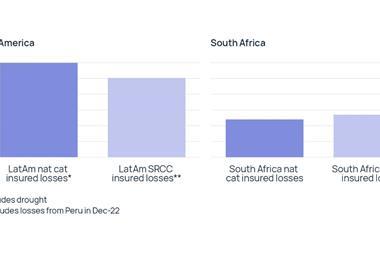Risk management takes on a new dimension when you operate 14 airports and airfields. Marie-Eve Albertelli of Aéroports de Paris says the art of risk management is in making sure all levels of a business communicate

Risk management is essential to any business, but its application and importance in the aerospace industry is especially striking. That’s particularly true if you are responsible for 14 different airports and airfields in a major urban area, as Aéroports de Paris (ADP) is.
ADP owns and manages most airports in the “ile-de-France” and deals with a huge amount of national and international air traffic. In 2009, 83 million passengers and about 74,000 aircraft passed through ADP installations.
Marie-Eve Albertelli was appointed risk manager at Aéroports de Paris late last year (she succeeded Frédéric Desitter, who was interviewed by StrategicRISK in January 2011). Albertelli is a graduate of the European University. At the beginning of her career she worked as a business controller for a media broker, preparing budgets among other administrative tasks. She then returned to her alma mater to do an MBA, after which she began working for ADP as a management consultant.
“Initially I worked mostly on the financial side of the business, particularly with information technology used in finance. Working in this context meant that I was dealing with a lot of risk management initiatives that allowed me to develop my understanding of the industry,” she says.
Companies need us
Albertelli gravitated towards risk management early on in her career. “It’s a wonderful tool that allows companies to highlight and understand their priorities. Risk management isn’t simply risk mapping and risk assessment, it’s about allowing companies to establish resilience strategies and efficient crisis management,” she says.
“Risk management is about establishing continuity within the company, and securing and effectively managing the most essential aspects of the business. As a risk manager you need to know exactly what’s going on at both the low and high levels of business within the company. Risk management allows companies to understand exactly where they want to go, and it helps get them there.”
The public is becoming increasingly risk averse. You would have to ask a sociologist or a philosopher as to why this trend is developing”
Albertelli believes that there have been significant developments within the industry during her own career.
“There used to be two separate trends developing in risk management. One came from the banking and insurance industry, which created a kind of default approach to this industry. Statisticians and insurance specialists would create sophisticated models that facilitated the development of internal control in companies. This allowed banks and insurance companies to qualify risk, to put a price on it and set up strategies to deal with it.
“At the same time, another trend was developing in highly technical industries, such as the aerospace industry. In this context, engineers would identify, assess and mitigate risk. They would set up resilience strategies as risk management was inherent to their companies’ corporate culture. We are now seeing a situation in many businesses where these two separate trends of risk management are meeting and becoming integrated.
“Risk management is no longer an administrative, or a technical, issue; it’s both. The position of the risk management department within a company, whether associated with audit or internal control or if it has more autonomy, is representative of a company’s approach to risk management in general.”
Good to talk
Like many of her peers, Albertelli believes one of the main challenges for risk managers is to establish a culture of risk throughout their companies. “One of the biggest challenges that risk managers face is the need to aggregate, and allow cross-fertilisation between the different dimensions of risk management,” she says.
“We are working with all levels of the company so we need to facilitate effective communication between all these key shareholders. There can be a lack of communication between the different people involved in risk mapping, risk assessment, IT security and crisis resilience. But risk managers need to ensure a consistent approach across all aspects of the business,” she says.
“Another challenge for risk managers is establishing a general culture of risk within the company. Risk management is about mitigating risks, which allows the company to have more opportunities. It’s not simply a bureaucratic or administrative task that has to be taken care of, it’s about integrating internal control with all the other aspects of the business.”
Albertelli consistently emphasises the importance of communication in her role at ADP. “Communication and integration is how risk managers mitigate risk for their companies. Being able to analyse a situation and communicate this to all parts of the organisation allows risk managers to prioritise their companies’ resources. Communication is one of the main ways that risk managers add value to their companies.
“I would say that the most important trait in a risk manager is the ability to communicate and facilitate dialogue between people. Facilitation skills are key in this industry. A risk manager prepares decisions for the board, so they have to be able to listen, analyse, synthesise, challenge different points of view
and communicate their views effectively. They have to be able to make risk management obvious and relevant to all parts of the company.”
Risks right now
Albertelli believes that world health, natural catastrophes and the financial crisis are the biggest risks to business in 2012. “The political and health situation in France or anywhere in the world is a major risk for ADP. The outbreak of an epidemic or the fear of an outbreak, as was the case with SARS in 2003 or the H1N1 flu virus, may adversely affect air traffic and lead to a drop in revenues and higher costs as a result of the sanitary measures implemented,” she says.
“The occurrence of events resulting from exceptional natural phenomena, such as the volcanic ash cloud caused by eruption of the volcano in Iceland in 2010, can have a significant impact on business activity. Storms or flooding can also seriously impede business. These events can disturb the operations of airport infrastructure in a direct way by reducing the operating capacity of facilities and can even lead to temporary closure.
“They may also have an impact on airlines, essential service providers and infrastructure that is essential to the running of the business, such as water, electricity, fuel supplies and road networks. These all have an indirect impact on the working capacity of business facilities.
“ADP’s revenue - and some of its subsidiaries’ revenue - is closely linked to fluctuations in air traffic levels. This revenue may be direct, as is the case with aeronautical fees that depend on aircraft movements and the number of passengers, or indirectly in the case of revenue generated from car parks and shops.
Air traffic levels also depend on factors such as the economic situation in France and abroad.
“A declining or stagnant economic climate could have a direct impact on the volume of traffic or the business of airlines, and subsequently on the group’s revenue and financial position.”
Apart from the developing political and financial crisis in Europe, Albertelli identified another important emerging risk to her industry this year. “An important trend that I have noticed is that the public is becoming increasingly risk averse. Take, for example, the heavy snow in Paris last year. For obvious safety reasons, the airports in Paris were operating at minimum levels and there were delays, but the airports were still open and they managed to absorb the French air traffic and some of the air traffic of other European countries.
“However, some people didn’t realise that the airports were open; it’s a refusal to accept risk or an abnormal situation. It can be very difficult to predict how the public will react to an abnormal situation. You would have to ask a sociologist or a philosopher as to why this trend is developing, but it’s certainly having an effect on risk management.”




















No comments yet